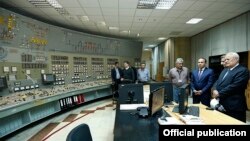Armenia could face a shortage of electricity unless it builds a new and large power plant in the coming years, energy experts from the World Bank warned in a report made public on Tuesday.
Their 67-page “policy note” analyzes challenges facing the Armenian energy sector and suggests concrete ways of confronting them.
“Armenia will need an additional power generation capacity in the near future in order to avoid supply shortages in the long run,” one of its authors, Artur Kochnakian, told reporters. He argued that the combined capacity of all Armenian power plants will fall well short of nationwide demand by 2026, the anticipated date of the decommissioning of the nuclear station at Metsamor.
Metsamor’s sole functioning reactor accounts for around 40 percent of electricity generated in the country annually. Its 30-year design life span ends in 2016. The Armenian government plans to modernize the 400 megawatt facility and keep it operational for 10 more years. It obtained last year a $270 million Russian government loan for that purpose.
The decision to extend Metsamor’s life reflected its failure so far to make good on its promises to build a new and twice as powerful nuclear plant. The government says that it is still committed to implementing the ambitious project worth billions of dollars. However, it has set no dates for the construction of the new plant.
The World Bank report does not seem to regard Metsamor’s replacement as a real possibility. It proposes instead that the government start looking for investors interested in financing the construction of a new 500 megawatt thermal power plant by 2020.
Two new gas-fired plants have already gone on stream in Armenia in the last few years. One of them was built in Yerevan in 2010 with a $247 million loan provided by Japan’s government. The state-owned facility has a capacity of 242 megawatts.
The other, more powerful thermal-power plant is located in the central town of Hrazdan. The Russian gas monopoly Gazprom inaugurated it in 2013.
Kochnakian agreed that investments in another gas-fired station will most probably necessitate a further rise in electricity prices in Armenia. State utility regulators are widely expected to raise them this month for a third time in two years.
Electricity in Armenia is already almost twice as expensive as it was in 2009. The World Bank report effectively justifies its growing cost, while acknowledging that Armenians are increasingly struggling to pay their energy bills
“Climbing energy costs increased the share of household energy expenses to 10 percent,” says the report. “It will get worse as the much needed new investments are made.”
The World Bank experts also stressed the importance of upgrading Armenia’s power transmission infrastructure. “Many transmission lines and substations incur high outage rates, which could lead to system-wide failure,” they warned.
Earlier this year, the World Bank provided the Armenian government with a $52 million loan to that will be used for modernizing some of these facilities. The government is due to contribute $17 million of its own funds to that project.




